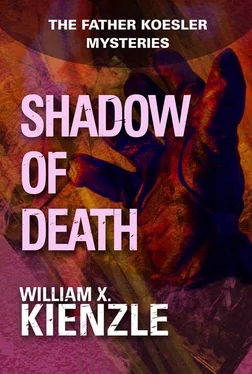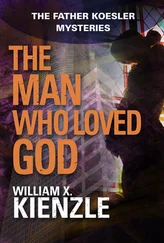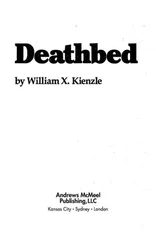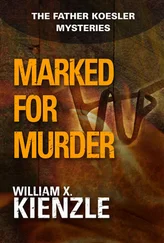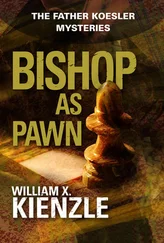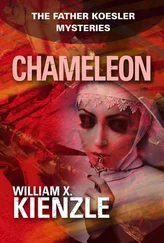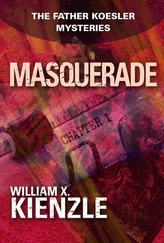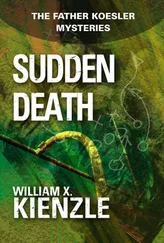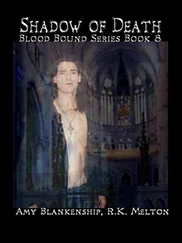He was in a huge vaulted chamber. The only furnishings were sets of sawhorses arranged to create an aisle down the middle of the room and across the back. Behind these sawhorses milled a growing throng. One thing was certain: This was a way station; whatever was going to happen was not going to happen in this anteroom.
Koesler was not alone in reaching this conclusion. After a brief conference, Cox and Lennon agreed they had no chance of covering the ceremony from this room. But where was the room, and how could they get to it?
The desired direction was soon made evident. An ecclesial procession was filing through the door at the left rear of the room, proceeding along the rear wall, and heading through the door at the right rear.
Koesler angled as close as he could to the path of the procession. There were several rows of people in front of him. However, his height made it possible for him to see at least the upper half of the procession. The crossbearer was followed by acolytes, then bishops, then Cardinals, then the new Cardinals—among them Cardinal Boyle—and finally, the Pope.
Applause rang out along the length of the procession, swelling when segments of the crowd recognized a favorite son. For the Pope, the applause was near-deafening.
Koesler was surprised. And a little disappointed. He was surprised that up this close the Pope lost much of his mystique. He was merely a wizened little old man. Koesler was disappointed that the Pope was so surrounded by Swiss Guards that it was difficult to catch sight of him. It must be the increased security.
It was incredible. Where else would one be given a special ticket just to stand in an unfurnished hall and look at other ticket holders for two to three hours while the ceremony you had come to see was going on somewhere else?
The only extraordinary item in the hall worth studying was the tall, imposing Swiss Guard securing the entrance to what was presumably the ceremonial room. Interesting history. Their uniform was said to have been designed by no less than Michelangelo, who was said to have modified it from a 1496 battle uniform. And, if memory served, during the sack of Rome in the sixteenth century, all but twelve of the Swiss Guard had died defending the Vatican Palace. One wondered what had been wrong with those twelve.
The present stance of this particular guardsman seemed to be what passed for “at ease.” Koesler recalled the ritual which demanded that each guardsman snap to attention each time a bishop or similar high ecclesiastic passed before him. What would happen, he wondered, if a bishop were to walk back and forth repeatedly in front of a guardsman, just to get him to salute. How long would the guardman’s patience last? But then, one probably wouldn’t be able to find a bishop with that peculiar a sense of humor.
Koesler glanced at his watch. 8:15. Theoretically, fifteen minutes into the ceremony. How long was one expected to stand in one place and study a Swiss Guard? It’s 8:15; do you know where your Swiss Guard is?
Then, something out of the ordinary took place. Joe Cox and Pat Lennon coolly stepped out from behind the barrier, walked purposefully to the guardsman, spoke to him briefly, displayed something in their wallets and walked past him into the ceremonial room.
Koesler pondered their maneuver a moment and decided, why not? It was unlikely the guardsman would run a poor priest through with his halberd.
He stepped into the aisle, walked up to the guard, opened his wallet, and displayed his supermarket check-cashing card, pointed toward the ceremonial room and said, “I’m with them.”
The guardsman, who seemed to neither recognize the card, nor understand English, simply shrugged.
Koesler, bracing himself, despite his earlier mental bravado, for a poke from the halberd, walked past him through the doorway. When nothing happened, he relaxed.
An opulent kaleidoscope unfurled before him.
Heads of state were glowing in their resplendent uniforms and brilliant sashes. The hierarchical vestments were, as always, magnificently impressive. And withal, there was that distinctive color known as cardinal red. The vivid meld of vermilion and orange was perhaps the most eye-boggling shade in the spectrum.
Even so, it was not as sumptuous as it had been before Pope Paul VI had simplified the Cardinal’s garb in 1969. Gone were the voluminous capa magna, the train of scarlet moire, the ermine cape, the golden tassels, the red leather slippers with gold or silver buckles.
But most of all, gone was The Red Hat.
It had been a purely ceremonial galero. With a normal crown but an overlarge brim and two strings of fifteen tassels each hanging from it. Of course, it was never actually worn. But heretofore, in the installation of a Cardinal, the hat, borne by two monsignors, had been touched symbolically to his head. It was then shipped home with the Cardinal and held in limbo until, at his death, it was hung from the ceiling of his cathedral.
Till recent years, it had been so distinctive a symbol that being named a Cardinal was more popularly referred to as receiving the red hat.
It was at this ceremony that the new Cardinals would have received the red hat. But now, the Pope would merely place on each Cardinal’s head a simple scarlet biretta.
The Pope had been speaking for a very long time. Every three or four paragraphs, he would switch to a different language. Koesler had lost count of the number of languages in which the Pope was proving himself fluent.
The time had come. As each Cardinal knelt before him, the Pope placed a biretta on the head of the new Prince of the Church, intoning, ‘For the praise of the omnipotent God and for the honor of the Apostolic See, receive the red hat, symbol of the great dignity of the Cardinalate, which means that you must show yourself to be fearless even to the shedding of blood for the exaltation of the Holy Faith, for the peace and tranquility of the Christian people, and for the liberty and expansion of the Holy Roman Church.”
At the words, “the shedding of blood,” Koesler was arrested by the memory of the slain Cardinal Claret and the airport attack on Cardinal Boyle. Clearly, the Pope’s words were not empty ones. For whatever reason, the Cardinal Archbishop of Toronto had shed his blood in violent death. And, if not for the alertness and swift action of Inspector Koznicki just a few days ago, Cardinal Boyle might not have lived to hear those words. Koesler wondered what thoughts were going through Boyle’s mind at this minute.
The attacks were incomprehensible to Koesler. The phenomenon of a deeply insecure person seeking instant fame by assaulting someone famous was, as Koznicki had sadly noted, becoming all too increasingly common. But Koesler, while accepting the explanation, could not understand it. And Cardinal Claret? Was his murder the same manifestation of a modern phenomenon, or was there something deeper, more sinister involved?
Ceremony completed, the exit recessional had begun. Now each Cardinal wore his new biretta. Again the applause. Again the cordon of Swiss Guards surrounding the Pope. Anyone determined to make the pontiff shed blood would have to smash his way through a phalanx of tall stalwart young men.
Koesler made his way out of the hall and down the seemingly infinite steps. Clearly, it was lots easier going down than coming up. He continued across St. Peter’s Square to the far section where the buses huddled like a herd of elephants.
As he was walking along the row of vehicles, Koesler heard his name called. Turning quickly, he struck his head against an outside rearview mirror on one of the buses. Feeling blood running down his face, he quickly put a handkerchief to the wound.
“Hey, Bob; sorry!” It was Father Brandon. “I wouldn’t have called to you if I had thought this would happen.”
Читать дальше
